Brand Social Media – Keys to Success, Best Practices and Most Popular Content
From identifying the right social networks for your business to adhering to each platform’s best practices and making it super-easy for followers to share your website and blog content, here’s a list of the most important things to do for brand social media success.
Brand Social Media Success Depends on Engagement
Many organizations fail to reap a return on social media marketing investments simply because they lack the knowledge needed to build an effective social media strategy. Here are three ways to improve brand social media marketing results in order to achieve your business goals.
Many business leaders embark on social media marketing with an enthusiasm that wanes quickly when efforts do not result in immediate sales or engagement. Here are three key areas that set apart successful brand social media strategies from the rest.
The First Key to Brand Social Media Success is Knowing Which Platforms to Use
Eenie, Meeny, Miny, Mo – To Which Social Network Should I Go?
Business marketers have hundreds of social sharing and publishing sites to choose from. Given the vast – and growing – number of options available, it’s critical that you identify the platforms which are most likely to provide you with the opportunity to accomplish your business goals.
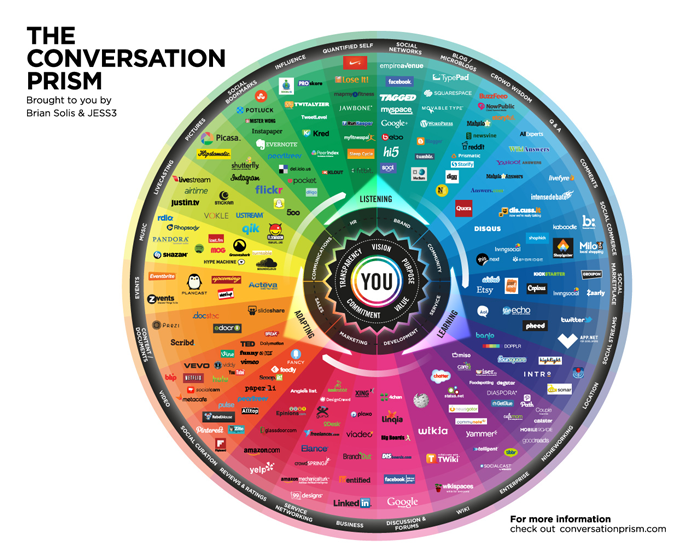
Initially, you should choose social networks which represent low hanging fruit; the social networks that have the most users, have the most users relative to your target audiences, or produce the highest return on investment for businesses like yours. Some of the questions that can guide you to the right social media platforms include:
- Which platforms are your target markets using?
- Which platforms provide the most conducive tools for brand social media interaction and engagement?
- Which platforms have you mastered, can you master, outsource or hire for most easily?
For most organizations, the foundation of an effective brand social media marketing strategy will start with the most popular social networks: Facebook, Twitter, LinkedIn, Google+ and (potentially) sites including Slideshare (B2B), Instagram, YouTube and Pinterest. Here’s a closer look at which social networks B2B and B2C brand marketers are using right now, and why.
The Social Networks Consumers Use Most
When it comes to identifying which platforms are right for your brand social media marketing, it’s important to distinguish between the platforms most effective for B2B marketers vs. platforms most effective for organizations that sell directly to consumers (B2C). When it comes to sheer numbers of social network users, here’s the overall breakdown:
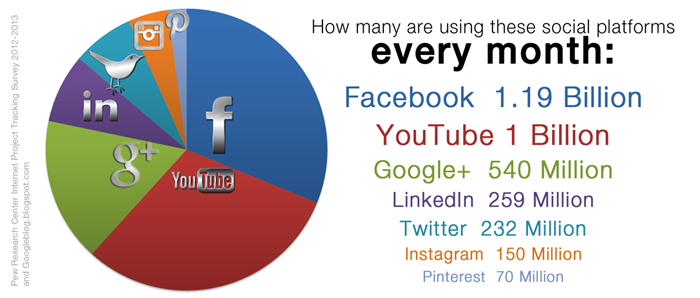
It should be noted that Pinterest should receive more attention from marketers. Among U.S. social media users, Pinterest is second only to Facebook for social sharing and comparing sale to sale, Pinterest-generated sales have the highest dollar amount compared to those generated via any other social networks – and about 2x as high as those generated by Facebook traffic (fastcompany.com).
Brand Social Media Platform Differentiators
Each of the social platforms available to marketers possess unique characteristics and strengths that could make them more or less useful for growing an online community, boosting SEO through social signals and driving web traffic. The following social media comparison infographic by leveragenewagemedia.com points to some of the key things to keep in mind when tailoring social media marketing strategies to each platform.
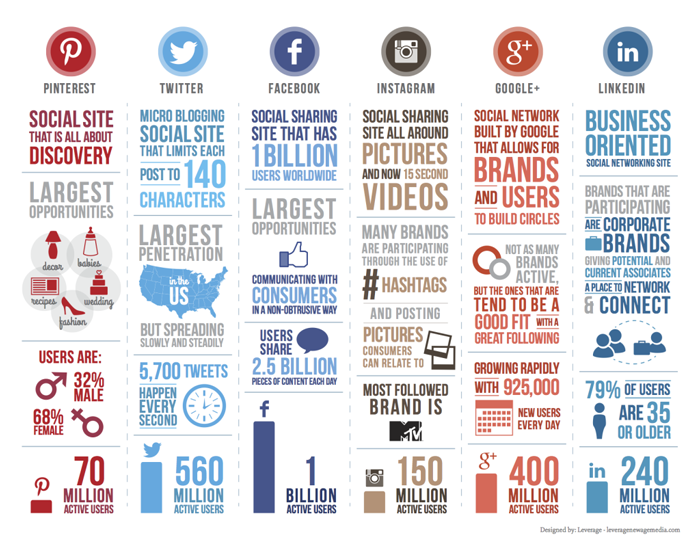
While Facebook has recently lost younger users, it remains the most popular social media network for sharing by the vast majority of U.S. adults, including the important Baby Boomer generation (and their children). Since recent changes have reduced the organic reach of posts, marketers may find more success by sponsoring specific posts with advertising dollars and targeting ads to niche market groups.
YouTube
Though not pictured on the graphic above, YouTube drives a significant amount of web traffic and can be used by a business to publish PowerPoint slideshows as well as videos and other animated content to the web. Publishing on YouTube provides additional social signals for search and each video page can be optimized to further enhance your ability to drive web traffic back to your own site.
Google+
Using Google+ for publishing and promoting content in conjunction with Google Authorship for posts can provide benefit not only for social sharing but organic search results, including the specific benefits ascribed to “social search,” which infuses content from those in your social circles into Google’s organic search results.
LinkedIn has evolved into a must-participate platform for business professionals. It drives a significant amount of web traffic and lead generation, primarily for B2B organizations. LinkedIn has also launched its own publishing platform, which provides another platform for B2B marketers on which to publish content, generate social signals for search engines and creates the opportunity for high authority backlinks.
One of the reasons to consider adding Twitter to your social media marketing strategy is its uniqueness. Designated a “microblogging” site, updates are limited to 140 characters (although expanded posts and photo posts are now also available).
Getting a few influential Twitter-enthusiasts to retweet your content can be beneficial in helping drive web traffic, grow your audience and gain brand awareness. One downside, posts have a very short lifespan, so adopting an automation platform like hootsuite.com that will allow you to schedule content reposts and post frequently throughout the day is advised.
Again, unique among social networks, Instagram is all at once a publishing platform and a tool by which you can publish content to other social networks. Since photos and videos are highly sharable and more likely to “go viral” than text alone, this platform can help a business market their products or services in creative ways, or tell a visual story about their business and its brand.
Pinterest is the second most popular social sharing site among US social media users. Since women account for an estimated 85% of all consumer purchases, marketers should not hesitate to add this female-user-dominated social network to their social media marketing strategy. It’s highly-visual format means that users stay on-site for a longer period of time and self-identify with images and content they identify with. Businesses can share blog and web content on Pinterest – provided their content contains images – which is a key way to make content more sharable (we’ll talk about the benefits of using videos and images in online content in part three).
If you are using social media marketing to grow your business, what you probably want most are sales, leads and brand awareness. Follow each platform’s best practices more strategically to achieve your goals.
Don’t Just Throw it Up Against the Wall – Use Social Media Marketing Strategically for Marketing ROI
Marketers who are unsure about how to use social media marketing strategically often become frustrated when their efforts fail to produce results. Find out how to use social networks as their designers intended, strategically, in order to accomplish your marketing goals.
At one time or another, you’ve probably heard a variation of the phrase, “Throw it up against the wall to see if it sticks.” It refers to the practice of throwing a spaghetti noodle up against the wall to see if it stuck. If it stuck, the spaghetti was done, if not, it needed more time in the pot.
All too often, marketers, unsure of how to get actual social media marketing results, simply throw a bunch of ‘stuff’ up against the wall of their social media profile or status updates to see if anything ‘sticks.’ It might work with spaghetti, but not with marketing.
Strategy + THIS Will Help You Get What You Want out of Social Media Marketing
Earlier we talked about the importance of using the social networks where we are most likely to find the biggest numbers when it comes to members of our target markets, and provided an overview of the general way each works and how it differs from the others, including:
- YouTube
- Google+
We will continue this discussion with some advice on best practices for posting type and frequency as well as provide links to articles you can use in order to develop a more strategic approach to social media marketing.
You might also like: 4 Ways to Be More Likeable on Social Media
 Best Practices for Facebook
Best Practices for Facebook
A large portion of your customers and target markets use Facebook on a regular basis. We know this, because 73% of all U.S. adults use Facebook, as of December 2013. What’s more, more than 3x as many people use Facebook as use any other single social network. (Pew Research Center’s Internet Project Tracking Surveys 2012-2013)
Our advice for Facebook users is to:
- Post 3-4x daily – use a free tool like Hootsuite to schedule posts out the day before, or even schedule several days out at a time.
- Become a thought leader or influencer among members of your target markets! Post only 1 promotional update for every 3-4 non-promotional status updates; non-promotional updates could be related to your industry or may represent other topics likely to interest, engage or educate members of your target markets.
- Set up a business page to use professionally and don’t cross the line; keep updates that are meant only for close friends or family, or that contain personal information, on your personal page and off of any social profiles that you use to grow your business.
- Create a persona and think through the “voice” you want your brand to have on social networks. Write posts in that voice on a consistent basis.
- Engage with your followers. Comment. Follow back. Like things. Be human. These platforms are called social networks – not billboards or ads – for a reason. The intent is that they be used interactively, one on one, by real people with other real people, even when being used for marketing a brand.
You might also like: 12 Best Practices for Media Companies Using Facebook Pages
 Best Practices for YouTube
Best Practices for YouTube
When you post to YouTube, don’t forget to apply the same type of optimization strategies to your title and description that you would apply to any other unique web page, including use of keywords and adding enough optimized content to help your content get found more often in online search.
You might also like: Optimization strategies & best practices for video content on YouTube
 Best Practices for Google+
Best Practices for Google+
Whether or not you have a lot of clients or members of target markets who participate on Google+, posting your content links on Google+ is likely to improve your SERP (search engine result placement — in other words —where your web site, blog or updates may be placed when someone searches online for a business like yours!)
Since about 70% of all searches occur on Google, it seems logical that social search signals from Google+ can help. Plus, when your contacts are logged in to their own Google account, your relevant content will show up in the first pages of their search results thanks to the “social search” aspect of the Google search engine algorithm.
Success in using the actual Google+ platform to engage members of your target markets depends on whether they are active on the network. As with Facebook, you will want to decide what type of content you want to share on Google+ at a ratio of roughly one promotional for every four non-promotional updates you post, and decide on a persona or voice to use on the network.
As with other social networks: Engage with your followers. Comment. Follow back. Like things. Be human.
You might also like: Moz’ Beginner’s Guide to Google+
 Best Practices for LinkedIn
Best Practices for LinkedIn
LinkedIn is very different from any other social network. It’s intended for professional use, by professionals, primarily for the purpose of interacting with other professionals but also for job seekers and talent seekers. In general, LinkedIn will be more effective for customer acquisition for B2B companies than those selling goods or services to consumers.
For both B2B and B2C professionals, LinkedIn is a great place to network and build your professional resume and professional portfolio, especially if it’s your desire to become an influencer in your field.
LinkedIn is also a great place to learn and get business tips, by joining groups and following and participating in conversations within those groups or following companies, industry leaders and influencers.
Post 3-4x daily. It may be fine to post the same things you post on Facebook to your updates on LinkedIn, especially for B2B sellers. Before posting in groups, be sure you read the group’s rules and try to share only the most relevant content. Share your own unique content as well!
As with other social networks: Engage with your followers. Comment. Follow back. Like things. Be human and be professional.
You might also like: LinkedIn’s resources for Company Pages
 Best Practices for Twitter
Best Practices for Twitter
Feel free to post the same updates to Twitter that you post on Facebook, but be aware that posts are limited to 140 characters. Make sure that you shorten posts or move links to the beginning as needed so that links back to your content aren’t lost at the end of a long update.
While on most networks you will not want to post more than a few times each day, the Twitter universe is completely unique and it’s not uncommon for brands to post several more times daily than on other social networks. Experiment with different wordings for links to the same content and posting at different times each day to find out when you get the most engagement among members of your target markets.
Consider using a free service like bit.ly to shorten links so they don’t take up so much of your post’s space.
As with other social networks: Engage with your followers. Comment. Follow back. Like things. Be human.
You might also like: Best practices for businesses at what, when and how you tweet
 Best Practices for Instagram
Best Practices for Instagram
One reason to consider adding Instagram to your social marketing strategy would be if you have a younger target market. Younger social media users have recently abandoned Facebook and one of the social networks they are favoring is Instagram.
You will be most likely to get marketing results using Instagram if you have a large segment of one or more of your target markets that use the network, as well as discovering how to engage them visually in order to add followers and stimulate sharing.
As with other social networks: Engage with your followers. Comment. Follow back. Like things. Be human.
You might also like: Best practices for Instagram

Best Practices for Pinterest
Pinterest’s purely visual platform makes it that much more important that you know what types of imagery will get the attention of members of your target markets and adopt an approach of testing with different images and posting times to see when your audience members are using the platform, since pins move down as new pins are added and may only be “above the fold” for a short period of time in a user’s feed.
One important tip is to not post too many pins of the same type at any one given time. A user might feel like they’re seeing too much of one thing and unfollow a board – or all your boards – and you’ll lose the chance to engage with them.
Your Pinterest strategy should include both promotional and non-promotional curated links. Try curating on several different boards, including both links back to your own branded content as well as other content that would likely be interesting to members of your target markets, even if some of your pins are not precisely on-topic as far as your business is concerned.
As with other social networks: Engage with your followers. Comment. Follow back. Like things. Be human.
You might also like: Pin Like a Pro for Business
More Resources
Use this chart to further strengthen your social marketing knowledge and strategy: The CMO’s Guide to the 2014 Social Landscape
Growing Online Community with More Followers and Shares is as Easy as A B C
Just as learning one’s ABC’s is foundational to success in reading and learning, learning your social marketing ABC’s is just as critical. This is how you grow an online community, facilitate follows and social shares in order to grow your lead pipeline, attract new customers and get more sales using social media.
Many brand marketers and small business owners set up social profiles only to minimize or abandon their social marketing efforts when their “if you build it, they will come” approach did not pan out with a vast online community of brand advocates and followers. Like any other marketing channel, social networks have their own audiences and best practices which – if understood and managed appropriately – can help an organization get new leads, attract new customers, engage and retain existing clients and boost the bottom line by closing sales they wouldn’t have gotten otherwise.
Success Growing an Online Community on Social Media is as Easy as A B C
A is for Accessible – as in, available, alert and responsive
B2B buyers and consumers alike expect for brands to respond immediately to questions, comments, complaints and suggestions provided on social networks. Yet how often have you seen a social profile that shows no signs of life for months at a time?
Someone in your organization must bear the responsibility of posting daily, monitoring social conversations for buying and interest signals, responding to comments and messages and so on.
B is for Believable – as in, a real being with an authentic human voice
Once upon a time, marketing collateral for brand identity sounded as though it were written by the founder and edited by not just one but a team of high school English teachers, to the point where it no longer sounded like it had been written by a real person at all.
Social updates, posts and messages are person-to-person communications, even when posted by a brand with thousands and thousands of followers. Brand marketers must decide and adhere to a consistent style across social networks that helps customers believe they are interacting with a real being, not a corporation.
Just like the hero or heroine of a novel, readers of a brand’s social profiles should come to know that brand through the voice used on its social channels.
C is for Compelling – as in, engaging, original, worthwhile and a motivator
US internet users spend a lot of time consuming content, a majority of which is social content. To get the attention of social readers, brand marketers must speak to their interests and put content into a format that compels readers to take some action; be it giving a thumb’s up signal, sharing the content with their own networks, visiting a website, completing a form, making a call or visiting a website or business.
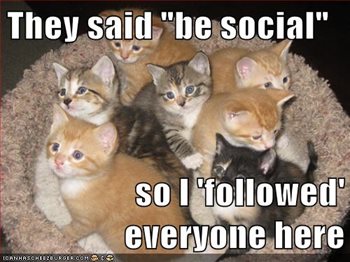
If You Want Your Social Post to Go Viral, Share a Picture of a Cat
In Cat Daddies: The Booming Business and Emerging Ethics of the Internet and Animals on digitaltrends.com, author Kate Knibbs notes that the most-consumed content on the web comes down to two categories, porn and pets. Citing the example of the Cheezburger Network site which has acquired more than $30 million in funding and is among the 400 most popular web sites worldwide, Knibbs says, “Animals are massive traffic draw.”
But let’s face it, most business content is not going to be able to be visually illustrated in cat photos.
How to Grow an Online Community When Your Content Isn’t Cat-Photo Friendly
For advice that is probably more helpful we can look to a New York Times study on the psychology of why people share content online that found out the reasons why people feel compelled to share content most often:
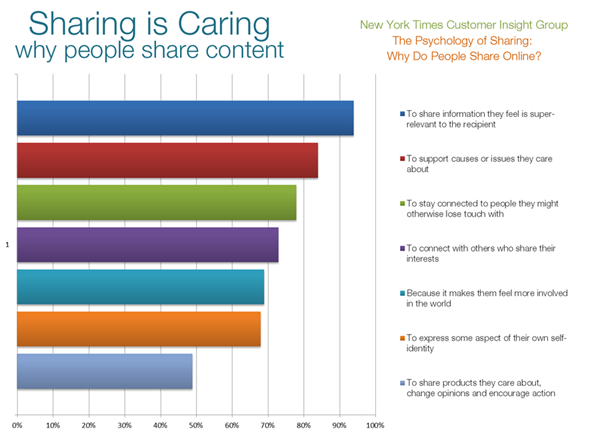
And socialmediatoday.com provides us with a list of the most popular types of content shared on social networks, according to an Ipsos study:
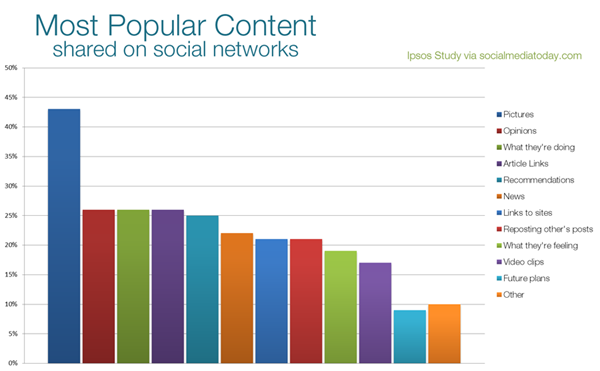
You Don’t Really Have to Share Pictures of Your Cat
Ultimately, getting followers and content virality comes down to finding and connecting with members of your target markets by providing them with information they need and may not be able to easily obtain elsewhere, or which sheds new light or a new, unique point of view on the challenges or problems they face.


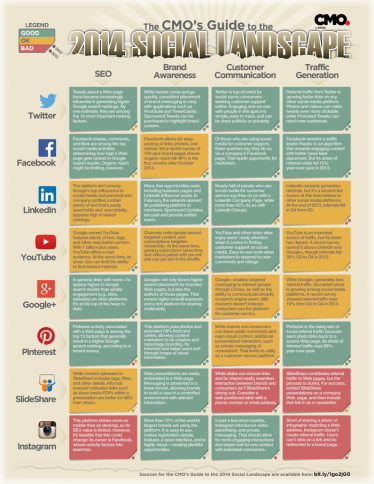
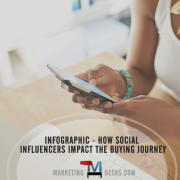



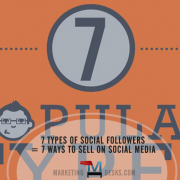




Trackbacks & Pingbacks
[…] recently covered some of the basics when it comes to best practices for the most popular social networks and also provided links where brand marketers will find more […]
[…] Big brands may have big numbers when it comes to followers, but they can’t touch the personal connection a small business owner can make with their audience on social networks. Here are four advantages small businesses can cultivate on social media. […]
Comments are closed.